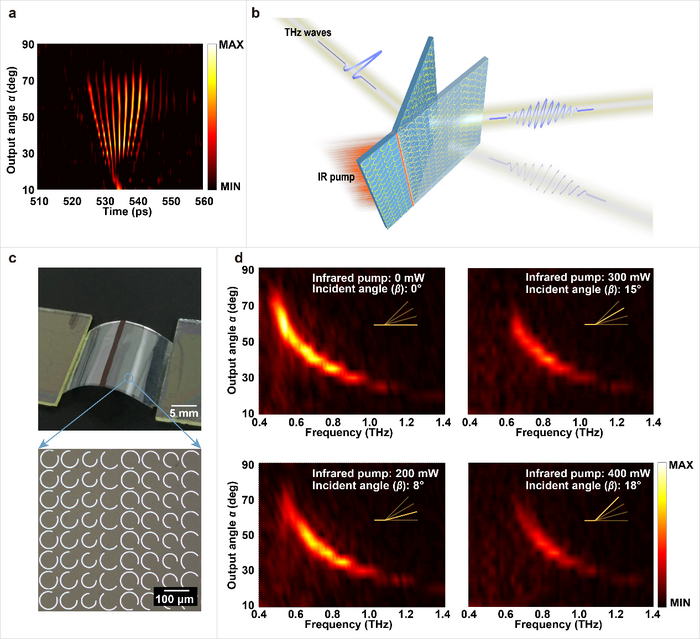Conventionally, active metasurface scientists have mainly concentrated on altering the dielectric constant and permeability of the substrate, which usually leads to resonance effect and ohmic loss. However, a reconfigurable metasurface based on mechanical deformation can evade these concerns.
 a, The received time-domain signals at varied output angles. b, Illustration of the infrared regulation of the LCE metasurface. c, The flexible LCE metasurface and the microscopic image of the C-shape split rings. The thick black line in the middle indicates the illumination position of the line-focused infrared light. d, Fourier transform of the received time-domain signals under 0, 200, 300, and 400 mW infrared pump. The insets indicate the deflection of the LCE metasurface. Image credits: Xiaolin Zhuang, Wei Zhang, Kemeng Wang, Yangfan Gu, Youwen An, Xueqian Zhang, Jianqiang Gu, Dan Luo, Jiaguang Han and Weili Zhang
a, The received time-domain signals at varied output angles. b, Illustration of the infrared regulation of the LCE metasurface. c, The flexible LCE metasurface and the microscopic image of the C-shape split rings. The thick black line in the middle indicates the illumination position of the line-focused infrared light. d, Fourier transform of the received time-domain signals under 0, 200, 300, and 400 mW infrared pump. The insets indicate the deflection of the LCE metasurface. Image credits: Xiaolin Zhuang, Wei Zhang, Kemeng Wang, Yangfan Gu, Youwen An, Xueqian Zhang, Jianqiang Gu, Dan Luo, Jiaguang Han and Weili Zhang
Still, mechanical reconfigurable metasurfaces—characterized by MEMS and FIB-induced deformation processes—remain challenging to construct or have inadequate resilience.
Being a novel type of liquid crystal polymer material, Liquid Crystal Elastomer (LCE) can have recoverable and controllable elastic deformation as a consequence of light irradiation or temperature rise, arousing massive interest in the communities of materials, bionics, and chemistry.
Its decent optical/thermal-induced deformation efficiency recommends that it will be a great element as an active part in reconfigurable metasurfaces, whereas it is seldom utilized to modulate metasurface response until now.
In a new study, a group of researchers headed by Prof. Jianqiang Gu from the Center for Terahertz Waves, Tianjin University, China, and Prof. Dan Luo from the Department of Electrical and Electronic Engineering, Southern University of Science and Technology, China, has synthesized a type of LCE made of liquid crystal crosslinking agent (RM257), liquid crystal monomer (RM006), and photoinitiator (Irgacure 651). The research was published in the journal Light Science & Application.
The strains produced in the LCE monolayer will twist the complete LCE to the molecular parallel orientation’s side when the temperature surpasses the phase transition point. The research team studied the LCE film as a flexible substrate to make a phase discontinuous metasurface with aluminum C-shaped split rings serving as resonators while getting active manipulation of broadband terahertz wavefront steering.
Eight C-shaped split rings with a phase interval of π/4, which are periodically organized on the LCE substrate, build the linear phase gradient of the metasurface.
Upon passing an incident terahertz wave through the metasurface, the orthogonal polarization’s output direction will deflect as per the generalized Snell’s law, which leads to terahertz wavefront steering. At the inception of the work, the C-shape split rings’ specific scales were found with numerical simulation, which is in outstanding harmony with the theoretical forecast, and then the designed LCE samples were produced by vacuum evaporation, photolithography, and wet etching processes.
The cross-polarized wave’s output angle via the LCE metasurface sample was quantified in an angle-resolved all-fiber terahertz time-domain spectroscopy system that is founded on asynchronous sampling. It was verified that the LCE metasurface functions as an excellent beam steerer that the output angle ranges between 70° and 25° for 0.48~1.1 THz.
To get the precise deflecting of the flexible LCE substrate, the femtosecond pulse with a 1030-nm central wavelength was concentrated on the edge of the sample through a cylindrical lens, making a focal line on the LCE substrate. The photo-thermal impact prompts LCE bending near the irradiated line, whereas the non-irradiated part stays flat, thereby getting the complete deflecting of the metasurface.
The scientists can regulate the deflecting angle of the LCE metasurface by modifying the pump IR light’s power, and the modulation speed can extend to the order of seconds.
The LCE metasurface deflects to various degrees with four pump powers. By increasing the pump power, the output angle slowly increases, and this angle increment at low frequency is more declared. The output angle of 0.68 THz terahertz wave attains the utmost tuning angle of 22° with the highest power infrared pump.
“We further investigated the performance and prospect of the proposed LCE metasurfaces as terahertz beam steerer, frequency modulator, and active beam splitter,” they stated.
“We believe that the potential demonstrated by our LCE metasurface provides considerable options for beam tracking, frequency filtering, and temperature sensing in the terahertz band, which in turn will advance R&D in next-generation wireless communication, terahertz imaging and terahertz spectroscopy inspection. The design principle proposed in this work can be extended to other frequency bands, opening a considerable path for the studies of active metasurfaces,” the scientists predict.
Journal Reference:
Zhuang, X., et al (2023) Active terahertz beam steering based on mechanical deformation of liquid crystal elastomer Metasurface. Light Science & Applications. doi.org/10.1038/s41377-022-01046-6.